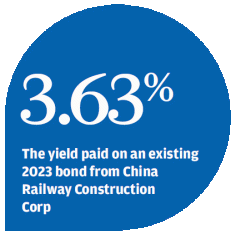
CRC taps demand for hybrid debt securities in US$500m issue
State-controlled railway firm is expected to raise US$500m in a deal viewed as attractive for investors with a fixed coupon of 4.25pc
State-controlled China Railway Construction Corp is tapping into new-found investor enthusiasm for hybrid debt securities that will allow it to raise new debt capital, yet have it treated as equity for accounting purposes.

Bankers call this the magic of hybrids. For investors, the question is whether the accounting tricks in the structure make it worth taking a bet on.
The deal - lead-managed by investment banks Citi, DBS, BNP Paribas, HSBC and UBS - is expected to raise US$500 million and pay a fixed coupon of 4.25 per cent.
Rating agencies often view perpetual bonds as equity. That was not the case for the CRCC offer, which was treated entirely as debt by the agencies.
The bonds, rated A3 by Moody's Investors Service, will see the coupon rise to US treasuries plus 5 per cent if they are not called - or repaid - in year five. That step-up in interest payments is punitive enough to effectively make the deal a five-year bond.
"The step-up means that there is a serious incentive to call it in year five, and the senior ranking means that is gives no protection for existing investors," said Thomas Jacquot, a Sydney-based senior director of Standard & Poor's, explaining why the agency viewed the instrument as debt.
Gordon Ip, a fund manager with Value Partners, said he was buying the deal. He liked the bond's senior ranking, the issuer's state-owned-enterprise status and, most of all, the yield.
The indicated fixed rate of 4.25 per cent is a big pickup over the current yield paid on a 2023 bond from the issuer of 3.63 per cent. Both bonds are senior securities. If one believes the perpetual bond will be called at year five, that deal pays more yield for taking a shorter risk - a clear bargain.
The issuer has the option to defer dividends on the perpetual bond - a negative for investors - but any income that is deferred is cumulative. It must be paid out eventually, with interest, making any deferral unlikely.
Many more Hong Kong and mainland issuers are examining the viability of the perpetual bond structures. Use of perpetuals rose 4½ times last year from 2012, according to Thomson Reuters.
Many issuers view the instrument as cheap equity, or financing that does not dilute ownership control, or earnings per share, and does not violate covenants on existing debt.
Investors like the increased income. Perpetual bonds are popular with private banking clients who are attracted to high headline yield figures.
Jacquot said it was not unusual for private banks to take 40 to 60 per cent of a perpetual bond offer in Asia.
The CRCC offer came with a small discount for high-net-worth investors, a tell-tale sign they were targeted in the distribution.
However, the structure does tend to divide investors. Some are wary of the instruments' generally weaker protection and greater price volatility.
Jamie Grant, the head of Asia fixed income at First State Investments, said that when Asian credit markets were whacked a year ago by comments from the US Federal Reserve about ending quantitative easing, perpetual bonds in Asia were among the worst hit, declining by as much as 20 to 30 per cent.
"Perpetuals are among the most volatile bonds," Grant said.
